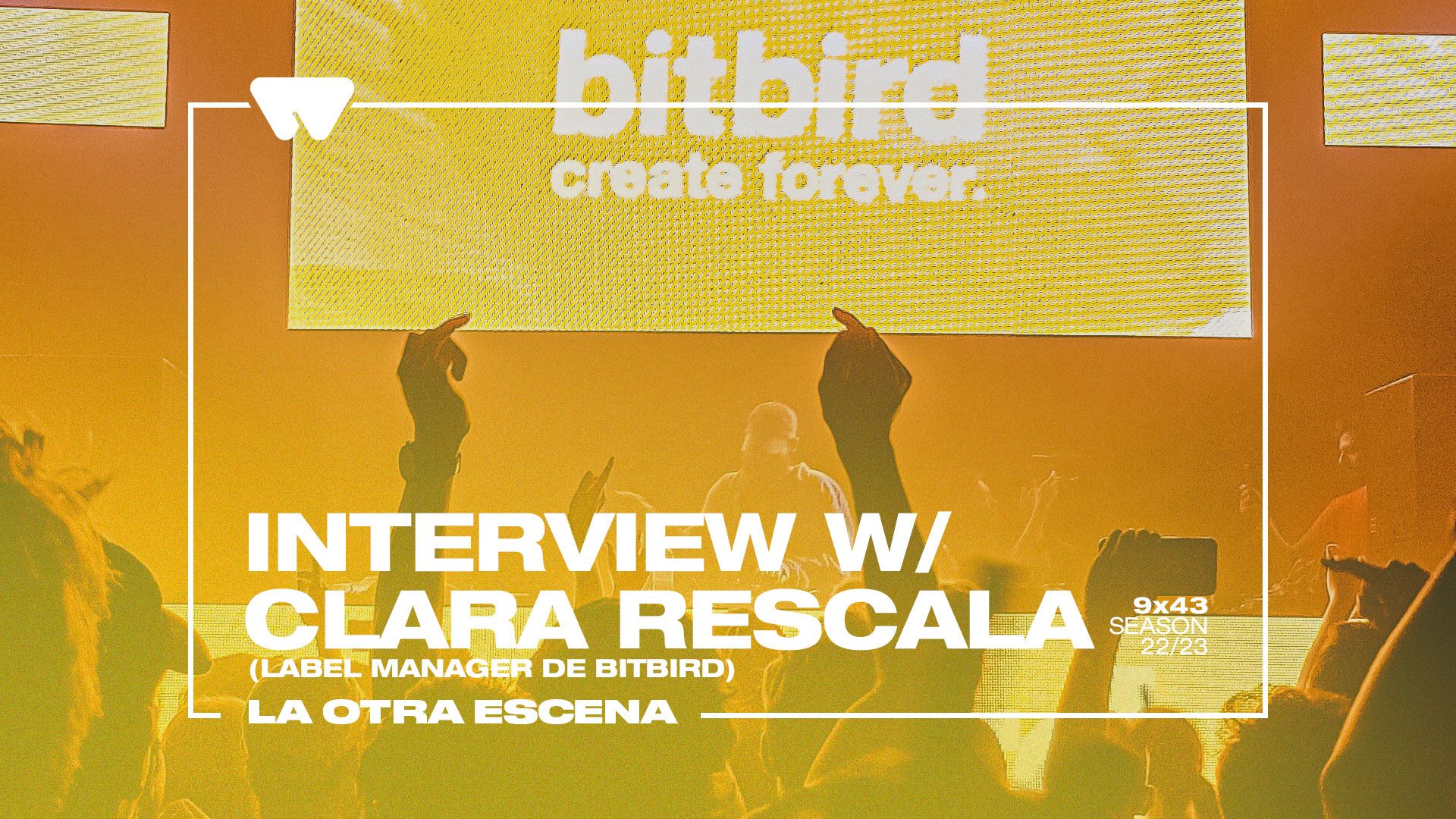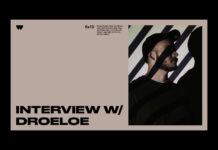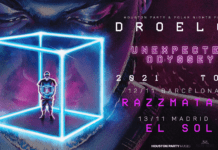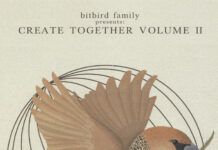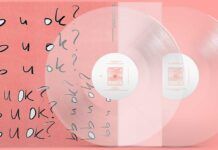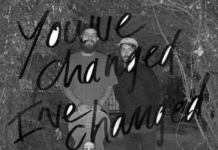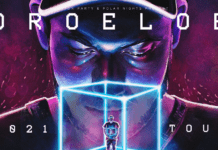Ser un sello independiente en el mundo de la electrónica no es una tarea fácil. Aún así, está claro que el ingrediente esencial para que éste triunfe es, sin duda alguna, el hacer las cosas “por amor al arte”. Ese es el caso de bitbird, discográfica fundada en 2014 por Sander van Dijck (al que muchos conoceréis por su alias artístico, San Holo) y su amigo y socio Thorwald van den Akker. Casi una década después de su primer lanzamiento, la marca y su comunidad siguen creciendo con una identidad intacta. Es por eso que nos sentamos con Clara Rescala, su label manager, para hablar de cómo funciona el engranaje por dentro, cuáles son los secretos para forjar una comunidad tan unida y fiel, el criterio a la hora de firmar artistas y planes de futuro para el sello.
Wololo Sound entrevista a San Holo
WOLOLO SOUND: Antes de nada: un placer conocerte, Clara.
CLARA RESCALA: Encantada de conocerte.
WS: Muchas gracias por esta entrevista exclusiva con Wololo Sound. Tenemos algunas preguntas sobre tu rol en el sello, pero comencemos con una pregunta simple pero importante: ¿Cómo estás?
CR: Estoy muy bien. Me encanta Barcelona, es mi ciudad favorita en todo el mundo. Así que siempre me encanta venir aquí. Amo la comida, amo el sol, amo como se viste la gente…
WOLOLO SOUND: First things first: Clara, nice to meet you.
CLARA RESCALA: Nice to meet you.
WS: Thank you very much for this exclusive interview with Wololo Sound. We have some questions about your role in the label, but let’s kick it off with a simple, yet important question: How are you?
CR: I’m very good. I love Barcelona, it’s my favorite city in the whole world. So I always love coming here. I love the food, I love the sun, I love how people dress…
WS: La razón por la que estamos aquí no es para tomar una cerveza –lamentablemente–, sino para hablar sobre tu trabajo, y es posible que algunas personas aún no estén familiarizadas con tu persona. ¿Podrías presentarte a nuestra audiencia y explicar cuál es tu trabajo?
CR: Soy Clara Rescala. Nací y crecí en Brasil, pero me mudé a los Países Bajos en 2020 y actualmente soy la label manager en bitbird. bitbird es el sello discográfico encabezado por el productor de música electrónica San Holo y formo parte del equipo desde principios de 2021.
WS: The reason why we are here isn’t to grab a beer –unfortunately–, but to talk about your role, and some people may not be familiar with your person yet. Could you please introduce yourself to our audience and explain what’s your job?
CR: I’m Clara Rescala. I’m originally from Brazil, born and raised. I moved to the Netherlands in 2020 and I’m currently the label manager at bitbird. bitbird is a record label spearheaded by electronic music producer San Holo and I’ve been part of the team since the beginning of 2021.
WS: Siendo del otro lado del mundo, tenemos mucha curiosidad sobre cómo terminaste trabajando en bitbird. ¿Cuál es tu experiencia profesional? ¿Cómo te encontraron o cómo los encontraste?
CR: Esa es una buena pregunta, en realidad, porque mi experiencia es en realidad en la música en vivo. Trabajé en la industria de la música en vivo durante nueve años antes de mudarme a los Países Bajos, pero también me mudé a los Países Bajos dos meses antes de que la pandemia se extendiera por todo el mundo.
WS: Qué puntería…
CR: Sí, el momento perfecto (risas). Así que tuve un primer trabajo en una empresa de venta de entradas y, por supuesto, ellos fueron los que se llevaron el mayor golpe, así que no me quedé en el equipo. Y luego inmediatamente pensé “Bueno, tal vez tenga que volver a marchar”. Y me encantaba la música en vivo. Nunca pensé que haría otra cosa. Pero acababa de terminar un máster en entretenimiento global y music business, y había aprendido mucho sobre música grabada, derechos de autor, royalties y todos los problemas relacionados con la música grabada en ese momento. Y estaba muy interesada, especialmente en los metadatos en ese momento. Me convertí en una súper friki y comencé a leer mucho sobre los problemas relacionados con los metadatos, y comencé a buscar empresas musicales en las que pudieras trabajar en inglés. Así que investigué mucho sobre empresas que pudieran hablar inglés. Sabía que no quería dejar la industria de la música, aunque sonara aterrador en aquel momento, etc.
Y luego encontré bitbird, e inicialmente tenían una vacante de Gerente de Operaciones porque estaba leyendo mucho sobre metadatos, y siempre fui muy buena organizando información y esas cosas. Solicité y obtuve el trabajo, y ese rol evolucionó hasta el que ocupo hoy en día.
WS: Being from the other side of the world, we’re really curious about how did you end up working at bitbird. What is your professional background? How did they find you or how did you find them?
CR: That’s a good question, actually, because my background is actually in live music. I worked in live music for nine years before I moved to the Netherlands, but I also moved to the Netherlands two months before the Pandemic moved everywhere in the world.
WS: Great timing…
CR: Yeah, perfect timing (laughs). So I had a first job at a ticketing selling company, and of course, they were the ones that got the biggest hit, so I didn’t stay on the team. And then I immediately thought, well, I might have to migrate. And I really loved live music. I never thought I would do anything else. But I had just finished a master’s in global entertainment and music business, and I had learned a lot about recorded music and copyrights and royalties and all the issues that were involving recorded music at the time. And I was very interested, especially in metadata at the time. I became a super nerd, and I started reading a lot about the issues that involved metadata, and I started searching for companies that you could work in English. So I did a lot of research of music companies that could speak English. I knew I didn’t want to leave the music industry, even though it sounded scary at that moment, etc.
And then I found bitbird, and initially, they had a position for Operations Manager, which I thought would be interesting because I was reading a lot about metadata, and I was always very good at organizing information and data. I applied for it, and I got the job, and that evolved into the role that I am today.
WS: Increíble. Entonces, ahora que estás en bitbird, que podemos considerar un sello electrónico indie, ¿podrías explicarnos la diferencia entre una major y un sello independiente?
CR: Pues, en pocas palabras, las tres principales discográficas son: Universal, Sony y Warner. Tienen una estructura enorme y muchas más posibilidades de financiar/invertir en proyectos más grandes. Todas estas grandes discográficas también poseen muchas discográficas que podrías pensar que son independientes, pero en realidad son propiedad de estas 3, lo que significa que pueden acceder al apoyo (tanto financiero como de la estructura más grande) proporcionado por las grandes. Y cuando lo piensas, Warner, Sony y Universal no solo están en el negocio de la música, ¿verdad? Tienen negocios relacionados con muchas otras formas de entretenimiento y tecnología, lo que por supuesto hace que su influencia sea aún mayor. Entonces, cuando digo que bitbird es un sello independiente, lo digo en serio porque no tenemos ningún apoyo o influencia “externa” de otro sello o marca, y sobrevivimos únicamente de los ingresos que obtenemos de nuestra propiedad intelectual.
WS: Amazing. So now that you’re in bitbird, which we can consider an Indie Electronic label, could you tell the difference between a major label and an indie label?
CR: So, in a nutshell the three major labels are: Universal, Sony, and Warner. They have a huge structure and much more possibility for funding/investing in bigger projects. All these major labels also own a lot of labels that you might think are indie, but they’re actually owned by these 3 – which means they can access support (both financial and from the bigger structure) provided by the majors. And when you think about it, Warner, Sony and Universal are not only in the business of music, right? They have businesses related to many other forms of entertainment and technology, which of course makes their influence even bigger. So when I say bitbird is an independent label, I really mean it because we don’t have any “external” support or influence from another label or brand, and we survive solely from the revenue we make from our Intelectual Property.
WS: Estabas hablando sobre los antecedentes de estos sellos y lo gigantes que son en comparación con los sellos independientes. Entonces, ¿cuál es la estructura en bitbird? ¿Cuántas personas están trabajando entre bastidores para que funcione?
CR: Sí, tenemos un equipo bastante pequeño, pero si lo comparas con los sellos en los EE. UU., ellos te dirán que somos un gran equipo porque creo que la mayoría de los sellos independientes en los EE. UU. trabajan con dos o tres personas, y nosotros somos un equipo de seis. Además, tuego tenemos dos becarios que suelen cambiar de vez en cuando. Pero sí, actualmente somos un equipo de seis personas.
WS: So you were talking about the background of these labels and how giant they are compared to independent labels. So what’s the structure in bitbird? How many people are working behind the scenes to make it work?
CR: Yeah, so we have a fairly small team, but if you compare to the labels in the US, they will say we are a big team because I think most indie labels in the US, they work with like two, three people top, and we are a team of six. And then we have two interns that usually change from time to time. But yeah, we are currently a team of six people.
WS: Después de dos años trabajando en bitbird, supongo que conocerás otros sellos que se mueven con los mismos o similares géneros musicales. ¿Qué dirías que diferencia a bitbird de otros sellos de música electrónica?
CR: Para mí, definitivamente es la selección y el tipo de música que lanzamos, lo cual es muy especial. Especialmente debido a la participación del propio San Holo, ya que él todavía dirige gran parte de la curación que hacemos. Pero para nosotros, la música que lanzamos tiene que estar relacionada con algún tipo de emoción. No lanzaríamos algo porque pensemos “Oh, suena muy bien comercialmente, va a ser una gran fuente de dinero, va a estar en todas las playlists”. Nunca publicaríamos eso si es algo con lo que no sentimos algún tipo de conexión, también emocionalmente. Eso hace que nuestro catálogo sea muy especial porque creo que nuestros fans también sienten esa conexión emocional con él y también están de acuerdo en que nuestra selección es muy específica.
Pero aparte de eso, somos muy amigables con los artistas. Y lo digo genuinamente porque somos propiedad de un artista y eso es lo más importante para él, para nosotros y para todos los demás que se unen y forman parte del equipo. Como te dije antes, yo misma soy hija de artistas, así que me aseguro de que los artistas que estén a bordo se sientan bien con lo que están haciendo y siempre sea una asociación. Los artistas con los que realmente no nos compenetramos son aquellos con los que terminamos no lanzando durante tanto tiempo, pero hay artistas que se unen y nos convertimos en socios de inmediato. Si ambas partes queremos crecer y creemos en el música de la misma manera, entonces ese es el artista con el que trabajamos durante más tiempo.
WS: After two years working at bitbird, I guess you might be aware of other labels that work with the same or similar genres of music. What would you say that makes bitbird different from other electronic music labels?
CR: For me, it’s definitely the curation and the type of music that we release, which is very special. Especially because of the involvement of San Holo himself and he still steers a lot of the curation that we do. But for us, the music that we release, it has to be related to some kind of emotion. We wouldn’t release something that, “Oh, it sounds very good commercially, it’s going to be a big money maker, it’s going to go all playlists”. We would never release that if it’s something that we don’t feel some sort of connection with, emotionally too. So that makes our catalog very special because I think our fans also feel that emotional connection to it and they also agree that our curation is very specific.
But other than that we are very artist-friendly and I mean that also like in the truest way of it because we are owned by an artist and that’s what’s important to him and it’s what’s important to us and to everybody else that comes on board and is part of the team. Like I told you before, I’m the daughter of artists myself, so making sure the artists feel okay with what they are doing and they’re on board and it’s always a partnership. The artists that we can’t really develop a partnership with are that we end up not releasing that long with, but the artists that come on board and we become partners right away, and we both want to grow, and we both believe in the music in the same way, then that’s the artist that we worked the longest with.
WS: Ahora que hablamos de lanzar música de artistas. ¿Cuál es el proceso desde que firmas con un artista hasta que lanzas su música?
CR: Así que hay dos formas de encontrar un artista: puedes buscarlo tú mismo o pueden encontrarnos, enviarnos demos y que nosotros la escuchemos. Eso depende. Por lo general, nuestro calendario de lanzamiento está programado de antemano a unos tres meses vista. Así que primero vamos a encontrar una fecha. Depende de si está lanzando un single, entonces puede ser algo que podamos encajar más fácilmente, o si tiene un producto más grande tenemos que pensar en el desarrollo del producto. Entonces, si es un EP, vamos a lanzar dos singles y luego el EP, o si es un álbum, vamos a lanzar más.
Así que realmente depende del tipo de producto que traes al sello y del tamaño del artista que eres también. Porque los artistas más grandes van a solicitar un mayor presupuesto de marketing y eso también influirá en cómo decidimos las fechas. Y luego, una vez que realmente nos gusta la música, comenzamos a hablar sobre las fechas, hacemos los contratos, encontramos las fechas, hacemos el lanzamiento de marketing, los artistas lo aprueban y eso es más o menos todo.
WS: So now we were talking about releasing music from artists. What’s the process from signing an artist to releasing their music?
CR: So there are two ways that you can find an artist: You can look for it yourself or they can send us demos and find us and we can listen to the demo. It depends. Usually, our release schedule is going to be booked for the next three months. So first we are going to find the date. It depends if you’re releasing a single so then it can be something that we squeeze in easier or if you have a bigger product and then we have to think about the rollout for the product. So if it’s an EP, we’re going to release two singles and then the EP, or if it’s an album, we are going to release more.
So it really depends on the kind of product that you are bringing to the label and kind of the size of artists that you are as well. Because bigger artists are going to request a bigger marketing budget and that will influence how we decide the dates as well. And then, once we really like the music, we start talking about dates, we’ll do the contracting, we find the dates, we do the marketing rollout, the artists will approve and that’s pretty much it.
WS: Una de las dos formas que mencionaste fue que los artistas se acercaran al sello. ¿Qué busca bitbird a la hora de fichar nuevos talentos o nuevos artistas?
CR: Bueno, como dije, tiene que ser música que realmente nos emocione de inmediato, especialmente si eres un artista más pequeño que requerirá más trabajo del lado del sello para ayudarte a crecer y ayudarte a encontrar tu audiencia, y realmente introducir esto a la audiencia que ya tenemos. Así que la música tiene que ser algo que todos digamos “Wow, esto es genial, realmente quiero lanzar esto de inmediato”. Y luego nos tiene que encajar, porque a veces la música es genial, pero no encaja con nuestro sonido o con nuestra audiencia. Hemos estado ampliando esto un poco más recientemente. Pero aún así, tiene que ser algo que realmente proyecte a bitbird porque ante todo somos curadores musicales y eso es muy importante para nuestra marca. Así que seguiremos buscando artistas que se ajusten a este sonido bitbird. Eso es importante para nosotros.
Pero sí, aparte de eso, miramos todo lo demás sobre el artista, como cómo es en las redes sociales. Por supuesto, eso también es importante. Es importante para todos, pero no es un factor determinante. Por ejemplo, si no tienes un TikTok, no voy a dejar de firmarte porque no tienes un TikTok. Ese no es realmente el caso. Pero, por supuesto, cuando el artista ya está activo en las redes sociales y ya tiene su propia audiencia, eso ayuda mucho con el lanzamiento, en ambos lados. No es solo porque pienso “Bueno, ahora mi trabajo va a ser súper fácil”. No, es porque vamos a poder ayudarlo de una manera y nos ayudamos entre nosotros y, al final, los resultados son muy buenos para todos los demás involucrados.
CR: Well, as I said, it has to be music that really touches us right away, especially if you’re a smaller artist that is going to require more work on the label side to help you grow and to help you find your audience and to really push this into the audience that we already have. So the music has to be something that we all are like “Wow, this is great, I really want to release this right away”. And then it has to fit because sometimes music is great, but it’s not a fit for our sound, not a fit for our audience. We’ve been expanding this a little bit more recently. But still, it has to be something that it really screens bitbird because we are curators first and foremost and that’s very important for our brand. So we will keep looking for artists that fit this bitbird sound. That is important for us.
But yeah, other than that we look at everything else about the artist like how he is on socials. Of course, that’s also important. It’s important for everyone, but it’s not a determining factor. Like if you don’t have a TikTok, I’m not going to not release you because you don’t have a TikTok. That’s really not the case. But of course, when the artist is already active on socials and has already his own audience, that helps a lot with the release, both sides. It’s not just because I think “Well now my job is going to be super easy”. No, it’s because we’re going to be able to help you one way and we help each other and in the end, the results are so good for everyone else involved.
WS: Desde mi punto de vista, una de las cosas que también hace que bitbird sea especial es la comunidad. Realmente prestáis atención a los fans y habéis creado una audiencia bastante sólida y fiel. ¿Cuál es el secreto detrás de eso? Porque supongo que muchas discográficas tienen como objetivo lograrlo como vosotros...
CR: Creo que San y Thor, que es su socio y también el dueño del sello, siempre estuvieron realmente comprometidos con los fans de la manera más pura posible. Iban a los espectáculos cuando San tocaba, y si Thor veía que alguien llevaba una camiseta de bitbird, después los llevaba al backstage para pasar un rato con los artistas. Así que siempre se conectaron con los fans de una manera muy verdadera. Como cada vez que San tocaba en diferentes ciudades, se reunían y estas personas tenían la oportunidad de conocerse en la vida real, de hablar con ellos y los escuchaban y hablaban de otras cosas, no solo sobre música. Así que siempre ha sido parte de ellos. Como que realmente quieren conocer a estas personas y conectarse con ellas.
Y con Discord, fue muy útil porque el canal de Discord en realidad fue creado por personas de la comunidad. No fue realmente como una iniciativa de bitbird. Ellos lo iniciaron y, por supuesto, eventualmente, les ayudamos a crecer. Pero desde entonces, porque nuestro lema es “create forever” (crear siempre), ¿no? Así que siempre fue algo que promovimos. Y me gusta pensar que eso ayuda a fomentar ese sentimiento de “sigue creando e involucrando a este artista”. Y luego, por supuesto, tenemos este proyecto llamado “create yogether”, que es como el epítome de este modelo ya que es un proyecto relacionado con la comunidad que realmente une todo lo demás.
WS: From my point of view, one of the things that also makes bitbird really special is the community. You really pay attention to the fans and you have created a pretty solid and supportive audience. So what’s the secret behind that? Because I guess a lot of labels aim to achieve it like you’ve done…
CR: I think San and Thor, which is his partner and also the label owner, were always really engaged with the fans in the most pure way possible. They would go to shows when San had to perform, and if Thor saw that anybody was wearing a bitbird t-shirt, they would call them backstage to hang out with the artists after. So they always connected with the fans in a very true way. Like whenever San was playing in different cities, they would do meetups and these people would actually get a chance to meet in real life and actually get a chance to talk to them and they would hear them out and talk about other stuff, not just about music. So it was always within them. Like they wanted to meet these people and connect with them.
And with Discord, it was very helpful because the Discord Channel was actually created by community people. It wasn’t really like a bitbird initiative. They started it and of course, eventually, we helped grow it. But ever since, because our motto is “create forever”, right? So it was always a thing that we pushed. And I like to think that helps foster that feeling of “keep creating and engaging this artist”. And then, of course, we have this project called “create together”, which is like the epitome of this model, which yeah, it’s a community-related project that really brings everything else together.
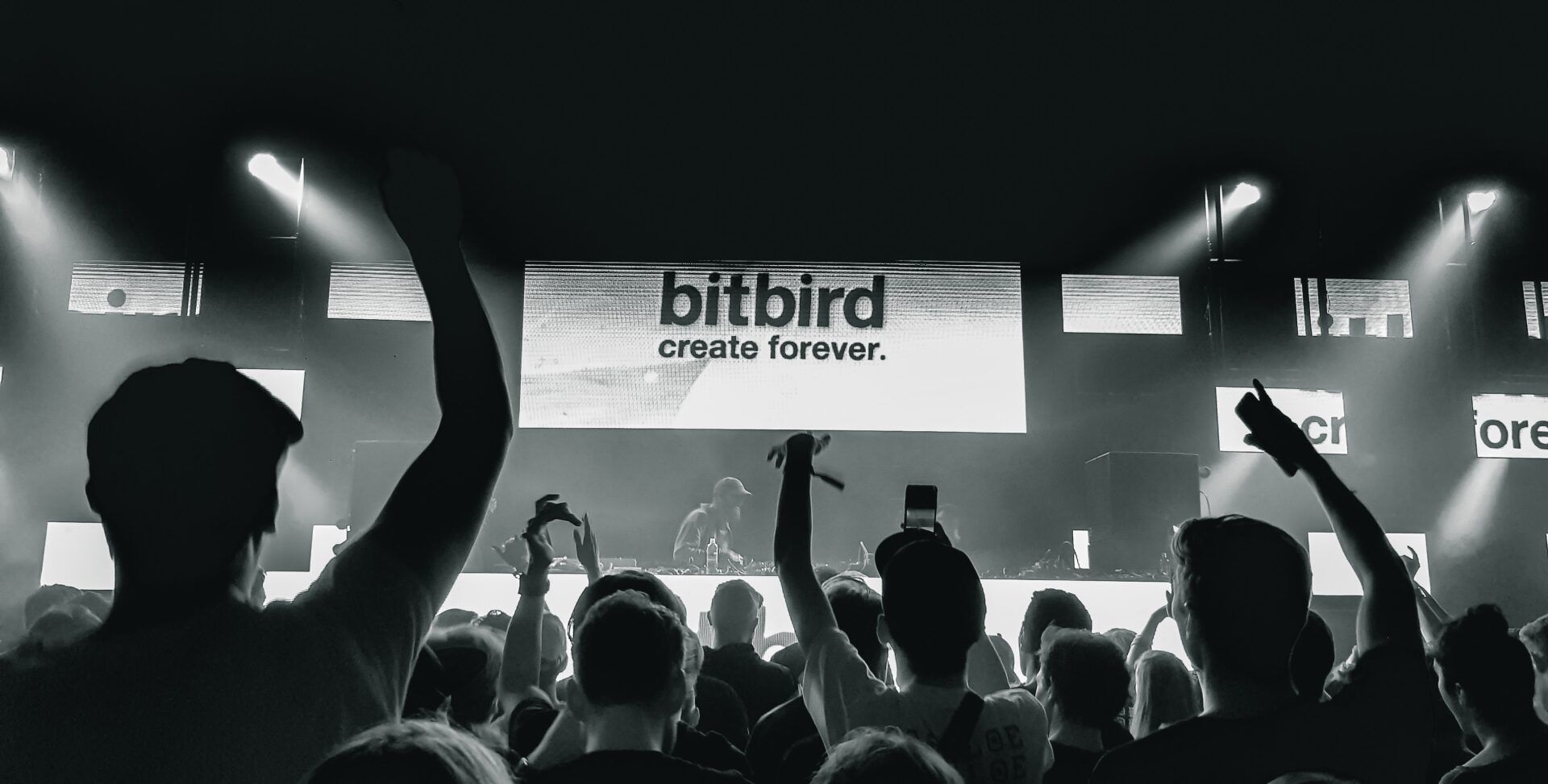
WS: “create together” es un proyecto realmente especial y os ayuda a destacar del resto de sellos. ¿Cómo se os ocurrió la idea de hacer eso? ¿Y cómo es la respuesta después de publicar eso?
CR: Por ahora, tenemos tres lanzamientos de “create together”, y la primera fue en realidad una idea que surgió de la comunidad. Crearon un desafío relacionado con la creación porque querían impulsar sus propias habilidades de producción. Una gran parte de la comunidad de bitbird son en realidad productores y artistas musicales. Querían presionarse mutuamente para mejorar sus habilidades de producción musical, por lo que se unieron, comenzaron a colaborar a través de Discord, crearon canciones increíbles y luego las enviaron al sello en forma de esta primera compilación de 10 pistas. Y desde el sello estábamos tan entusiasmado que lanzamos el primero y luego, para el segundo, pensamos que había formas de mejorarlo. Entonces, lo que hicimos es que ahora todos los años tenemos el mes de “create together”, en el que los artistas de nuestro sello dan talleres gratuitos y hablan con los fans sobre diferentes cosas: sobre producción, actuaciones en vivo, o un montón de cosas relacionadas con la creación.
Y después de este mes, estos niños o estos productores pueden reunirse en Discord o de cualquier otra manera. Pero por lo general, los talleres se transmiten a través de Twitch y luego regresan a Discord y comienzan a crear juntos. Y luego tenemos curadores musicales dentro de la comunidad que hacen la primera lista filtrada. Luego, el sello escucha eso y seleccionamos los definitivos. Entonces, la participación de la comunidad es desde el principio. Creo que es por eso que funciona tan bien, porque se les ocurre y los ayudamos a mejorarlo para hacerlo crecer. Desde entonces, para cada entrega de la compilación estamos poniendo más esfuerzo, los estamos ayudando a impulsarla más y más porque realmente creemos en dar espacio a estas voces que de otra manera probablemente no se escucharían.
Estaba este artista de la compilación del año pasado… Envié a todos los artistas algunos cuestionarios de marketing para que los respondieran. Y hubo un artista que dijo: “He estado escribiendo música durante mucho tiempo, nunca pensé en lanzarla, solo la escribía para mí. Y luego, aunque no colaboré con nadie en la compilación, ver cómo colaboraban me inspiró, así que os lo envié”. Y la suya era como la canción principal de la compilación, era una de nuestras favoritas, de lejos. Y también ha demostrado ser un gran A&R. Algunos de los artistas que lanzaremos este año a los que les está yendo muy bien, de hecho los descubrimos a través de “create together”. Así que todos ganamos.
WS: “create together” is a really special project and helps you stand out from the rest of the labels. How did you come up with the idea to do that? And how’s the feedback after releasing that?
CR: For now, we had three installments of “create together”, and the first one was actually an idea that came from the community. They created a challenge related to creating because they wanted to push their own production skills. A big part of the bitbird community is actually music producers and artists. They wanted to push each other to improve their music-producing skills, so they came together, started collaborating through Discord, created amazing tracks, and then they just sent to the label like this first compilation of 10 tracks. And the label was so excited about it that we released the first one and then, for the second one, we thought there are ways that we can even enhance that. So what we did is that now every year we have the “create together Month”, so artists from our roster will give free-of-charge workshops, and we’ll speak to the fans about different things: about production, performing live, or a lot of things related to creating.
And after this month these kids or these producers can get together over Discord or whatever other way. But it’s usually so that the workshops are streamed through Twitch and then they go back to Discord and start creating together. And then we have curators from the community that do the first shortlist. Then, the label listens to that and we select the final ones. So the involvement of the community is from the very early start. I think that’s why it works so well, because they come up with it and we just help them enhance it for more. So for each installment of the compilation, we are putting more effort, we are helping them push it forward more and more and more because we really believe in giving space to these voices that otherwise probably wouldn’t be heard.
There was this artist from last year’s compilation… I send all artists some marketing questionnaires they can answer. And there was this one artist that said “I’ve been writing music for a very long time, never thought about releasing it, I just wrote it for myself. And then, even though I didn’t collaborate with anyone in the compilation, seeing how they were collaborating inspired me, so I applied”. And his’ was like the focus track of the compilation, was one of our favorites, like all over. And it has proven to be a great A&R too as well. Some of the artists that we are releasing this year that are doing very well, we actually discovered them through “create together”. So it’s a win-win.
WS: Por último pero no menos importante, como gerente del sello, ¿cuáles crees que son los próximos objetivos principales a lograr, o cuál es el próximo “monstruo final por derrotar”? Algo que sería tanto en lo personal como para el sello, significaría mucho y sería un paso importante.
CR: Creo que desde el año pasado hemos estado invirtiendo cada vez más en fiestas, fiestas con la marca bitbird, lo que creo que es una gran oportunidad. Una de las mejores maneras de involucrar a los fans es tocar en vivo y poder brindarles a los artistas que nos entusiasman un espacio en el que puedan tocar en vivo y conectarse con el público de una manera diferente. Esta ha sido una de las cosas más gratificantes que hemos hecho, y realmente queremos ampliar eso.
Mi “gran sueño” por el que preguntas sería tener un escenario propio en un festival, que sería como lo más de lo más. Pero ya veo a todos los artistas que estamos firmando ahora siempre nos preguntan “Si tienes un espacio, ¡realmente quiero tocar en vivo!”. Por supuesto que quieren, todo el mundo quiere. Y las actuaciones en directo se han convertido en algo costoso de manejar para la mayoría de los artistas. Por ejemplo, las giras son más caras que nunca, pero al mismo tiempo, es un gran momento. Por lo general, cuando hacemos esas fiestas, son cinco artistas de bitbird diferentes, y se conocen en la vida real, tocan juntos y, a veces, de ahí surgen colaboraciones. Entonces, especialmente porque tengo experiencia en música en vivo, esto es como algo muy personal. Pero los dueños del sello también están de acuerdo con eso.
WS: Last but not least, as the label manager, what do you feel are the next main goals to achieve, or what’s the next “big boss to defeat”? Something that would be both personal and also for the label, would mean a lot and would be an important step.
CR: I think we’ve been since last year investing more and more in parties, bitbird branded parties, which I think is like such a great opportunity. One of the best ways to engage fans is when you play live and be able to provide the artists that we are excited about a space in which they can play live and connect with audiences in a different way. This has been one of the most rewarding things that we did, and we really want to expand on that.
My “ultimate dream” you ask would be to have a festival stage, a branded festival stage, that would be like the top of the top. But I think it’s all the artists that we are signing now they’re always asking “If you have a space, I really want to play live!”. Of course, they want, everybody does. And live has become an expensive thing for most artists to handle. Like, touring is more expensive than ever, but at the same time, it is a great moment. Usually, when we do those parties, it’s five different bitbird artists, and they meet in real life, and they play together, and sometimes collaborations come out of it. So it’s especially because I have a background in live music, that this is like my dear and near to my heart. But also the label owners also agree with that.
WS: Antes de terminar, algunas preguntas rápidas:
WS: ¿Lanzamiento favorito en bitbird hasta ahora?
CR: ¡¡Esa es muy difícil!! Pero el tema que acabamos de lanzar de OddKidOut llamado ‘THIEF‘ es sin duda uno de mis lanzamientos favoritos de todo bitbird.
WS: Canción no electrónica favorita tuya.
CR: Bueno, entonces mi artista favorito de todos los tiempos se llama Gilberto Gil. Es un artista brasileño, tiene como 80 años. Él tiene esta canción que es el tipo de canción que escucho cuando estoy muy estresado y necesito calmarme. Se llama ‘Refazenda‘.
WS: ¿Comida favorita?
CR: ¡Oh, eso es tan difícil! Aunque me encanta la comida. La comida es literalmente una de las razones por las que vivo. No sé, estoy en España, me inclino a decir paella, pero ni siquiera es cierto. Creo que diría que la comida tailandesa es en general mi comida favorita.
WS: ¿Palabra favorita en español?
CR: “Joder” (risas). No, lo cambiaré. ¿Cuál es mi palabra favorita en español… “Gracioso”! Porque significa algo completamente diferente en portugués, y me encanta… Es muy divertido para mí que signifique eso en español.
WS: ¿Qué significa en portugués?
CR: Por ejemplo, alguien que es “gracioso” en portugués es un hombre encantador, y en español significa “divertido”, así que me encanta.
WS: Artista de ensueño que te gustaría firmar con el sello.
CR: Eso es difícil…
WS: Por ejemplo, si tiene algún presupuesto, personalmente, ni siquiera necesita preguntarle a San.
CR: (Risas) No sé, esa es una pregunta difícil porque hay tantos artistas que están en nuestra lista en este momento que me encantaría firmar. Creo que uno de ellos sería Imanu, que también es un artista holandés. Nos gustaría firmarlo con la etiqueta. Pluko también es un artista que realmente nos encantaría fichar. Ni siquiera son tan grandes, pero musicalmente encajan bien. Creo que esos dos estarían en la parte superior de mi lista, en realidad.
WS: Por último, pero no menos importante, ya que estamos en Primavera Sound, ¿cuál es el acto que más ganas tienes de ver?
CR: Eso es fácil: ¡Rosalia! (Risas) Vine hasta aquí por ella.
WS: Before we wrap things up, some fast questions:
WS: Favorite release on bitbird as of now?
CR: That’s so difficult!!! But the track that we just released, from Oddkidout, called ‘THIEF‘, is totally one of my all-time favorite bitbird releases.
WS: Favorite non-electronic song of yours.
CR: Okay, so my favorite all-time artist is called Gilberto Gil. He’s a Brazilian artist, he’s, like, 80 years old. He has this one song that it’s the kind of song that I listen to whenever I’m very stressed and I need to be calmed. It’s called ‘Refazenda‘.
WS: Favorite food?
CR: Ooh, that’s so hard! I love food, though. Food is literally one of the reasons why I live. I don’t know, I’m in Spain, I’m inclined to say paella, but that’s not even true. I think I would say Thai food’s overall my favorite food.
WS: Favorite Spanish word?
CR: “Joder” (laughs). No, I will change it. What is my favorite Spanish word… “Gracioso”! Because it means something completely different in Portuguese, and I love… It’s so funny to me that it means that in Spanish.
WS: What does it mean in Portuguese?
CR: Like, someone who’s “gracioso” in Portuguese is a charming man, and in Spanish it means “funny” instead, so I love it.
WS: Last but not least, since we are in Primavera Sound, the act that you’re looking forward to seeing the most?
CR: That’s easy: Rosalia! (laughs) I came all this way for her.
WS: Muchas gracias, Clara. Ha sido un placer.
CR: ¡Gracias!
WS: Thank you very much, Clara. It’s been a pleasure.
CR: Thank you!


